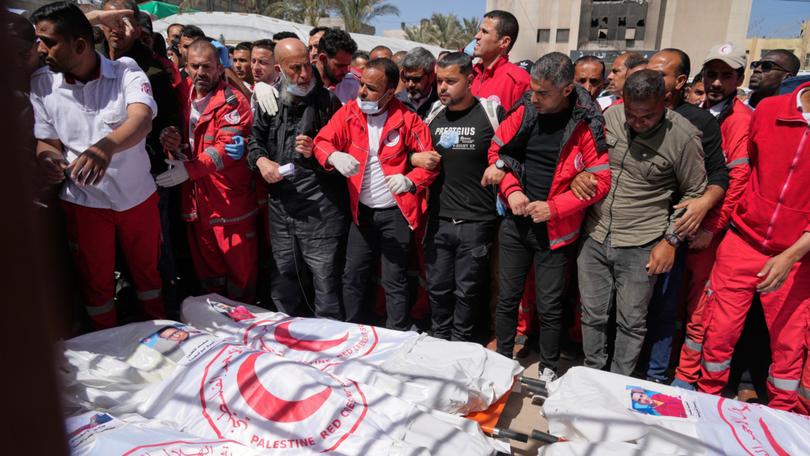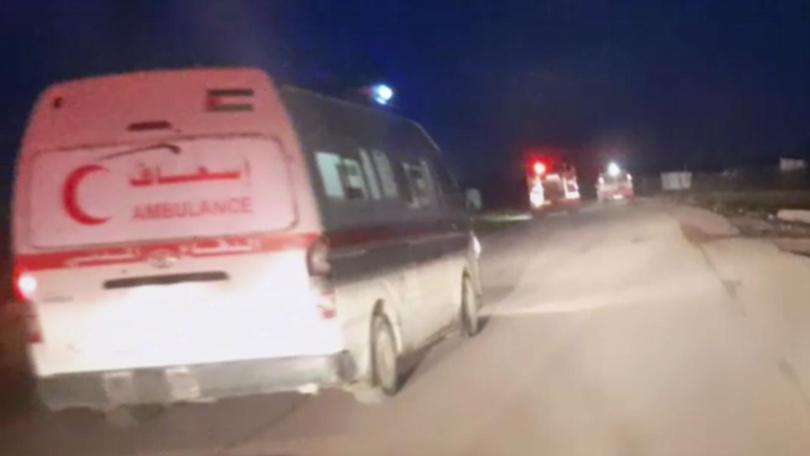The Washington Post: IDF says ‘misunderstanding’ led to killings of Gaza emergency workers

The Israeli military says it has dismissed the field commander of a special forces unit that shot and killed 14 emergency workers and a UN employee in Rafah in southern Gaza last month and attributed the killings to an “operational misunderstanding,” following a weeks-long investigation.
The inquiry, which could still lead to criminal charges from a military prosecutor, concluded that the soldiers did not summarily execute any of the unarmed emergency workers, but it left key questions about the killings unanswered.
The Israel Defense Forces had previously admitted to opening fire on several waves of vehicles driven by humanitarian personnel on the morning of March 23 but offered shifting explanations for why.
Sign up to The Nightly's newsletters.
Get the first look at the digital newspaper, curated daily stories and breaking headlines delivered to your inbox.
By continuing you agree to our Terms and Privacy Policy.Briefing journalists on Sunday, the lead IDF investigator, retired Maj. Gen. Yoav Har-Even, described a cascade of apparent mistakes that began before dawn, when a unit from the military’s Golani Reconnaissance Battalion mistook an ambulance for a Hamas police vehicle.
Following the initial encounter, during which two paramedics were killed and one survivor was detained, the field commander said he believed that their unit had encountered Hamas forces, according to Har-Even’s account.
When a second wave of rescue vehicles arrived an hour later to help the first ambulance, the field commander opened fire from 100 feet away, believing the occupants were reinforcements.
And when a United Nations pickup truck arrived minutes after that, the commander fired again even though the unit, by then, had realised they had killed unarmed paramedics, Har-Even said.
All told, 15 paramedics and rescue workers, including a U.N. employee, were killed in at least three waves of IDF gunfire and then buried in a mass grave.

The field commander, who serves as the deputy head of the Golani Reconnaissance unit, was dismissed for providing an “inaccurate report” during his debriefing and for firing on a clearly marked U.N. truck - an action that was “against the rules of engagement, 100 percent,” Har-Even said.
“The forces acted under the strong impression they were facing an immediate threat; this was their state of mind,” Har-Even said, calling the incident an “operational misunderstanding.”
In a statement, Breaking the Silence, an organization of IDF veterans critical of the military’s conduct in occupied Palestinian territory, described the investigation as “riddled with contradictions, vague phrasing, and selective details.”
Dispatcher recordings and testimonies indicate that at least two of the emergency workers were still alive after troops advanced close enough to identify them.
Minutes after Raed al-Sharif, 25, arrived and was shot, he called his dispatch center to report that his colleagues were all dead or wounded on the ground, according to Nebal Farsakh, a spokeswoman for the Palestine Red Crescent Society (PRCS).
Saleh Muammar, 42, whose ambulance had led the charge there, was still on the line with another dispatch center in central Gaza more than 30 minutes after Har-Even said troops realized their mistake.
Ibrahim Abu Kass, a Red Crescent medic who was at the central Gaza center at the time, said soldiers were overheard on the line calling Muammar to come closer, but he didn’t respond.
A little later that morning, another medic, Assad al-Nassasra, called the same dispatchers. PRCS workers video recorded the call, which captured the voices of soldiers in the background.
They shouted in Arabic for someone to “shut [their] mouth,” then told other troops that the area around them was now a “sector” for detainees.
The International Committee of the Red Cross said Monday that it had located Nassasra, 47, in an Israeli detention facility but was not granted access to him.
IDF officials did not identify the field commander responsible for the killings on March 23 but said he had previously been wounded in combat in Gaza and held dual foreign citizenship.
A senior officer, a colonel who headed the 14th Brigade, was also censured, the Israeli military said.
For weeks, the IDF killings have been one of the most heavily criticized and scrutinized incidents of the Gaza war, because of the fact that multiple waves of unarmed emergency workers were killed by the unit — and by the disclosure of videos and other evidence that contradicted the Israeli account of events.
While the IDF initially said the first vehicle its soldiers fired on was a “Hamas police” car carrying terrorists, interviews and dispatcher records obtained by The Washington Post showed it was an ambulance that had been dispatched on an emergency call shortly before PRCS and carried a team of three paramedics.
After the emergency workers were found buried near their vehicles in a shallow grave, the IDF said its forces had fired on vehicles advancing suspiciously, without emergency lights.
When a cellphone video from one of the paramedics showed troops opening fire on the emergency workers as they ran to help wounded colleagues, the IDF said soldiers had believed the men were militants trying to ambush them.
A Post analysis, based on dispatcher records, witness testimony, video footage, satellite imagery and photographs of the dead, contradicted the official Israeli narrative in key regards.
While the Israeli military said the soldiers shot from afar, it showed the gunfire initially came from a distance at which the paramedics would have been clearly identifiable.
On Sunday, the IDF conceded key elements of that narrative, but failed to fully address how surviving rescue personnel were treated at close quarters.
It said that in the aftermath of the killings, its intelligence officials identified six of the 15 killed as Hamas-affiliated “operatives,” but did not provide any evidence.
IDF officials acknowledged that all of the killed emergency workers were wearing paramedic vests and were unarmed.
In drone video footage that the IDF shared with reporters on Sunday, the soldiers could be seen shooting the emergency vehicles as they drove in a convoy and firing at relatively close range at an occupant trying to flee.
Har-Even said the Israeli soldiers, operating in darkness and wearing night-vision goggles, only realised they had shot unarmed paramedics when they were at point-blank range.
Military experts told The Post that the night-vision goggles probably would have amplified, not obscured, the light from the emergency vehicles, and that the red flashing lights probably would have been visible to the naked eye as well.
Har-Even, who led the IDF investigation, said there was no indication that the mass burial of the 15 bodies was a cover-up. The decision was made by senior military officials to protect the bodies from wildlife on a day when thousands of Gazans were set to be evacuated along that same road.
But the decision to use bulldozers to crush the emergency vehicles — which was also seen by critics as a sign of Israeli troops hiding evidence of a war crime — was mistaken, Har-Even said.
The body of a staffer from the UN agency for Palestinian refugees was later identified in a mass grave, along with 14 Palestinian emergency workers.
A senior UN official, speaking on the condition of anonymity to discuss the sensitive issue, said the agency believed that the man had been driving to work.
“Too many civilians, including aid workers, have been killed in Gaza. Their stories have not all made the headlines,” said Jonathan Whittall, head of the UN Office for the Coordination of Humanitarian Affairs in Gaza, who led the U.N. mission to recover the bodies from the mass grave.
- - -
Loveluck reported from London, Shih from Tel Aviv and Berger from Jaffa, Israel. Meg Kelly in Washington also contributed to this report.
© 2025 , The Washington Post
